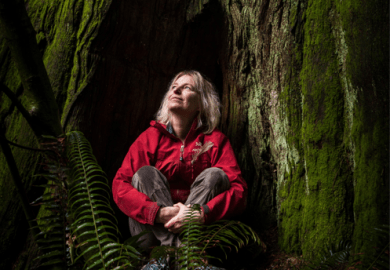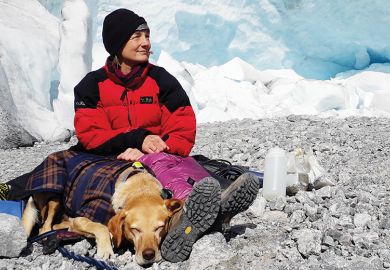To read the story of David M. Hopkins is to read the story of Beringia itself. Beringia, the landmass now situated on either side of the Bering Sea, fragmented into east and west, is today only a geographic placeholder in time. But 18,000 years ago, when sea levels were lower because much of the Earth's water was ice, the Bering Land Bridge united this desolate windswept landscape that was home to mammoth, giant bison, tundra lions and saiga. It was over this broad coastal plain that the first Native Americans ventured into the Americas.
It was here that Hopkins spent most of his interdisciplinary career, conducting field research that integrated geomorphology, oceanography, volcanology, archaeology, palynology and indigenous oral histories into a story that for ever changed the way northern scholars conduct research. For those of us who were his students, he was truly a giant, clearing a path across both tundra and science like a mammoth on the arctic steppe grasslands of the Pleistocene epoch. A giant of intellect and kindness, he left a mark on all of us that went beyond his articles and reports, his books or his teachings. Now this legacy is enshrined in a beautiful and engrossing book by Dan O'Neill.
On the University of Alaska campus is a small log cabin built 75 years ago by Ivar Skarland that has been home to a suite of Arctic science luminaries. It was here Hopkins lived when he became a distinguished professor and taught evening seminars in geomorphology, periglacial landforms and Beringia. It might have been - 45C outside, but he lit fires that still burn today. He taught us to question knowledge and beliefs at all times, he taught us to write and he instilled in us a powerful sense of social conscience. He believed that one should never get attached to ideas - that an idea, hypothesis or theory was only good until the next field season, when it could be thrown out for something better.
He was a wonderful science writer and editor. I remember him reading The New York Times with a red pen, the front page covered in editorial marks.
But perhaps his most enduring teaching, which permeates all aspects of our scientific careers, was that we should always fight against social injustice, inequalities, poverty, oppression and governmental abuse of military power. He treated all students equally and as if they were future colleagues.
In this context, O'Neill relives the development of Hopkins' two great syntheses, The Bering Land Bridge (1967) and The Palaeoecology of Beringia (1982), partly from the view of the scientific and global politics of the time, but mostly from the observation that Hopkins integrated, reviewed and even rewrote most of the chapters and forced dozens of scholars to think beyond their particular area.
O'Neill tells Hopkins' story and places it in the midst of a scientific mystery combining science, adventure and personality. This wonderful integration of science and history, of anecdote and theory, of reflection and controversy, is the most complete review of our understanding of Beringia and of how that knowledge came to be. It is an apt memorial to the greatest Beringian scientist who ever lived. I recommend it to anyone interested in the Arctic, the Pleistocene epoch, Native Americans, archaeology, geology, exploration... well, I recommend it to everyone.
Herbert D. G. Maschner is associate professor of anthropology, Idaho State University, US.
The Last Giant of Beringia: The Mystery of the Bering Land Bridge
Author - Dan O'Neill
Publisher - Basic Books
Pages - 231
Price - £16.99
ISBN - 0 8133 4197 3
Register to continue
Why register?
- Registration is free and only takes a moment
- Once registered, you can read 3 articles a month
- Sign up for our newsletter
Subscribe
Or subscribe for unlimited access to:
- Unlimited access to news, views, insights & reviews
- Digital editions
- Digital access to THE’s university and college rankings analysis
Already registered or a current subscriber? Login



